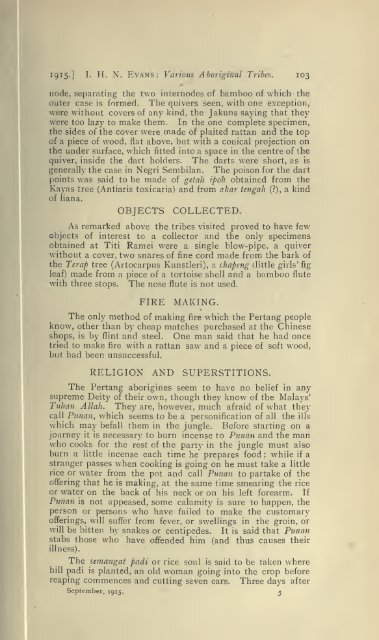Journal of the Federated Malay States museums - Sabrizain.org
Journal of the Federated Malay States museums - Sabrizain.org
Journal of the Federated Malay States museums - Sabrizain.org
Create successful ePaper yourself
Turn your PDF publications into a flip-book with our unique Google optimized e-Paper software.
igi5.] I. H. N. Evans: Various Aboriginal Tribes. 103<br />
node, separating <strong>the</strong> two internodes <strong>of</strong> bamboo <strong>of</strong> which <strong>the</strong><br />
outer case is formed. The quivers seen, with one exception,<br />
were without covers <strong>of</strong> any kind, <strong>the</strong> Jakuns saying that <strong>the</strong>y<br />
were too la^y to make <strong>the</strong>m. In <strong>the</strong> one complete specimen,<br />
<strong>the</strong> sides <strong>of</strong> <strong>the</strong> cover werernade <strong>of</strong> plaited rattan and <strong>the</strong> top<br />
<strong>of</strong> a piece <strong>of</strong> wood, flat above, but with a conical projection on<br />
<strong>the</strong> under surface, which fitted into a space in <strong>the</strong> centre <strong>of</strong> <strong>the</strong><br />
quiver, inside <strong>the</strong> dart holders. The darts were short, as is<br />
generally <strong>the</strong> case in Negri Sembilan. The poison for <strong>the</strong> dart<br />
points was said to be made <strong>of</strong> getah ipoJi obtained from <strong>the</strong><br />
Kayas tree (Antiaris toxicaria) and from akar tengah (?), a kind<br />
<strong>of</strong> liana.<br />
OBJECTS COLLECTED.<br />
As remarked above <strong>the</strong> tribes visited proved to have few<br />
objects <strong>of</strong> interest to a collector and <strong>the</strong> only specimens<br />
obtained at Titi Ramei were a single blow-pipe, a quiver<br />
without a cover, two snares <strong>of</strong> fine cord made from <strong>the</strong> bark <strong>of</strong><br />
<strong>the</strong> Terap tree (Artocarpus Kunstleri), a chapeng (little girls' fig<br />
leaf) made from a piece <strong>of</strong> a tortoise shell and a bamboo flute<br />
with three stops. The nose flute is not used.<br />
FIRE MAKING.<br />
The only method <strong>of</strong> making fire which <strong>the</strong> Pertang people<br />
know, o<strong>the</strong>r than by cheap matches purchased at <strong>the</strong> Chinese<br />
shops, is by flint and steel. One man said that he had once<br />
tried to make fire with a rattan saw and a piece <strong>of</strong> s<strong>of</strong>t wood,<br />
but had been unsuccessful.<br />
RELIGION AND SUPERSTITIONS.<br />
The Pertang aborigines seem to have no belief in any<br />
supreme Deity <strong>of</strong> <strong>the</strong>ir own, though <strong>the</strong>y know <strong>of</strong> <strong>the</strong> <strong>Malay</strong>s'<br />
Tulian Allah. They are, however, much afraid <strong>of</strong> what <strong>the</strong>y<br />
call Punan, which seems to be a personification <strong>of</strong> all <strong>the</strong> ills<br />
which may befall <strong>the</strong>m in <strong>the</strong> jungle. Before starting on a<br />
journey it is necessary to burn incense to Punan and <strong>the</strong> man<br />
who cooks for <strong>the</strong> rest <strong>of</strong> <strong>the</strong> party in <strong>the</strong> jungle must also<br />
burn a little incense each time he prepares food ; while if a<br />
stranger passes when cooking is going on he must take a little<br />
rice or water from <strong>the</strong> pot and call Punan to partake <strong>of</strong> <strong>the</strong><br />
<strong>of</strong>fering that he is making, at <strong>the</strong> same time smearing <strong>the</strong> rice<br />
or water on <strong>the</strong> back <strong>of</strong> his neck or on his left forearm. If<br />
Punan is not appeased, some calamity is sure to happen, <strong>the</strong><br />
person or persons who have failed to make <strong>the</strong> customary<br />
<strong>of</strong>ferings, will suffer from fever, or swellings in <strong>the</strong> groin, or<br />
will be bitten by snakes or centipedes. It is said that Punan<br />
stabs those who have <strong>of</strong>fended him (and thus causes <strong>the</strong>ir<br />
illness).<br />
The semangat padi or rice soul is said to be taken where<br />
hill padi is planted, an old woman going into <strong>the</strong> crop before<br />
reaping commences and cutting seven ears. Three days after<br />
September, 1915. 5

















